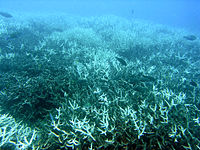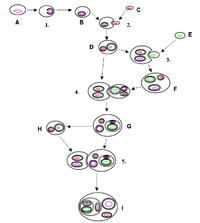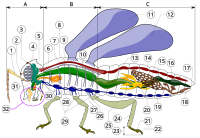
What Goes Up Might Come Down: the Spectacular Spread of an Endosymbiont Is Followed by Its Decline a Decade Later
Sign Up to like & getrecommendations! Published in 2019 at "Microbial Ecology"
DOI: 10.1007/s00248-019-01417-4
Abstract: Facultative, intracellular bacterial symbionts of arthropods may dramatically affect host biology and reproduction. The length of these symbiont-host associations may be thousands to millions of years, and while symbiont loss is predicted, there have been… read more here.
Keywords: symbiont; rickettsia infection; frequency; rickettsia ... See more keywords

Cultivation Conditions Can Cause a Shift from Mutualistic to Parasitic Behavior in the Symbiosis Between Paramecium and Its Bacterial Symbiont Caedibacter taeniospiralis
Sign Up to like & getrecommendations! Published in 2018 at "Current Microbiology"
DOI: 10.1007/s00284-018-1493-1
Abstract: Caedibacter taeniospiralis is an obligate bacterial symbiont living in the cytoplasm of the ciliate Paramecium tetraurelia. Different studies analyzing the effect of this symbiont on its host’s growth and maximal cell density arrive at contradicting… read more here.
Keywords: cultivation conditions; symbiont; caedibacter taeniospiralis; bacterial symbiont ... See more keywords

Thermally tolerant symbionts may explain Caribbean octocoral resilience to heat stress
Sign Up to like & getrecommendations! Published in 2021 at "Coral Reefs"
DOI: 10.1007/s00338-021-02116-8
Abstract: Coral reef ecosystems are under threat from the frequent and severe impacts of anthropogenic climate change, particularly rising sea surface temperatures. The effects of thermal stress may be ameliorated by adaptation and/or acclimation of the… read more here.
Keywords: resilience; symbiont; heat stress; thermal tolerance ... See more keywords

Reference genes for quantitative real-time PCR analysis in symbiont Entomomyces delphacidicola of Nilaparvata lugens (Stål)
Sign Up to like & getrecommendations! Published in 2017 at "Scientific Reports"
DOI: 10.1038/srep42206
Abstract: Nilaparvata lugens (Stål) (Hemiptera: Delphacidae) is a major rice pest that harbors an endosymbiont ascomycete fungus, Entomomyces delphacidicola str. NLU (also known as yeast-like symbiont, YLS). Driving by demand of novel population management tactics (e.g.… read more here.
Keywords: yls genes; symbiont; entomomyces delphacidicola; reference ... See more keywords

Defensive symbiosis against giant viruses in amoebae
Sign Up to like & getrecommendations! Published in 2022 at "Proceedings of the National Academy of Sciences of the United States of America"
DOI: 10.1073/pnas.2205856119
Abstract: Protists are important regulators of microbial communities and key components in food webs with impact on nutrient cycling and ecosystem functioning. In turn, their activity is shaped by diverse intracellular parasites, including bacterial symbionts and… read more here.
Keywords: symbiosis giant; defensive symbiosis; symbiont; bacterial symbionts ... See more keywords

Unravelling the relationship between the tsetse fly and its obligate symbiont Wigglesworthia: transcriptomic and metabolomic landscapes reveal highly integrated physiological networks
Sign Up to like & getrecommendations! Published in 2017 at "Proceedings of the Royal Society B: Biological Sciences"
DOI: 10.1098/rspb.2017.0360
Abstract: Insects with restricted diets rely on obligate microbes to fulfil nutritional requirements essential for biological function. Tsetse flies, vectors of African trypanosome parasites, feed exclusively on vertebrate blood and harbour the obligate endosymbiont Wigglesworthia glossinidia.… read more here.
Keywords: symbiont; relationship tsetse; tsetse fly; unravelling relationship ... See more keywords

Genetic manipulation allows in vivo tracking of the life cycle of the son‐killer symbiont, Arsenophonus nasoniae, and reveals patterns of host invasion, tropism and pathology
Sign Up to like & getrecommendations! Published in 2019 at "Environmental Microbiology"
DOI: 10.1111/1462-2920.14724
Abstract: Summary Maternally heritable symbionts are common in arthropods and represent important partners and antagonists. A major impediment to understanding the mechanistic basis of these symbioses has been lack of genetic manipulation tools, for instance, those… read more here.
Keywords: symbiont; genetic manipulation; vivo; pathology ... See more keywords

Cellular and potential molecular mechanisms underlying transovarial transmission of the obligate symbiont Sulcia in cicadas.
Sign Up to like & getrecommendations! Published in 2022 at "Environmental microbiology"
DOI: 10.1111/1462-2920.16310
Abstract: Vertical transmission of symbionts in insects is critical to persistence of symbioses across host generations. The key time point and related cellular/molecular mechanisms underlying the transmission in most insects remain unclear. Here, we reveal that… read more here.
Keywords: insects; symbiont; molecular mechanisms; transmission ... See more keywords

Shuffling between Cladocopium and Durusdinium extensively modifies the physiology of each symbiont without stressing the coral host.
Sign Up to like & getrecommendations! Published in 2021 at "Molecular ecology"
DOI: 10.1111/mec.16190
Abstract: As sea surface temperatures increase, many coral species that used to harbor symbionts of the genus Cladocopium have become colonized with the thermally tolerant genus, Durusdinium. Here, we asked how gene expression in the symbionts… read more here.
Keywords: symbiont; physiology; host; cladocopium durusdinium ... See more keywords

Development of Common Leaf-Footed Bug Pests Depends on the Presence and Identity of Their Environmentally Acquired Symbionts
Sign Up to like & getrecommendations! Published in 2022 at "Applied and Environmental Microbiology"
DOI: 10.1128/aem.01778-21
Abstract: Leptoglossus zonatus and L. phyllopus are important polyphagous pests, and both species have been well-studied but generally without regard to their dependance on a bacterial symbiont. Our results indicate that the central role of Burkholderia… read more here.
Keywords: ecology; leaf footed; leptoglossus; development ... See more keywords

Insect Bacterial Symbiont-Mediated Vitellogenin Uptake into Oocytes To Support Egg Development
Sign Up to like & getrecommendations! Published in 2020 at "mBio"
DOI: 10.1128/mbio.01142-20
Abstract: Many insects harbor obligate bacterial symbionts that can be vertically transmitted to offspring by female insects through eggs. Here, we report that leafhopper vitellogenin (Vg) recognizes and binds a surface channel molecule (porin) on the… read more here.
Keywords: insects; egg development; symbiont; obligate bacterial ... See more keywords